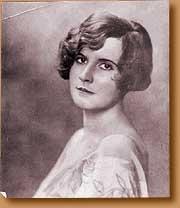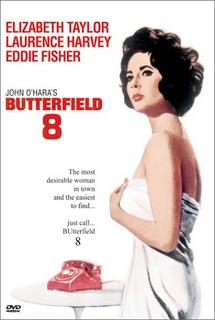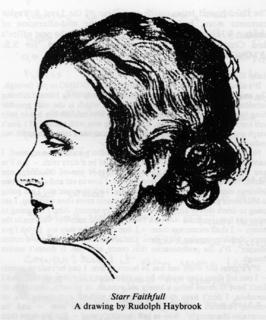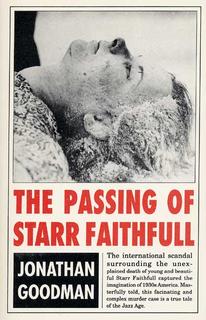Starr Faithfull makes poets like Christopher T. George muse.
The Waste Land by Orson Welles I. THE BURIAL OF THE DEAD
.
Hollywood is the cruelest place, breeding
anorexia in the brightest starlets, mixing
money and desire, stirring
dull talent with sharp aspirations.
Citizen Kane kept me sober, covering
Hearst's yellow journalism in black and white.
(Critics wondered if the film portrayed Hearst’s ego
or mine.) My Ambersons were not merely magnificent,
they were sublime! To the merry sound of a zither,
on Vienna's giant ferris wheel, I said,
"In Italy for 30 years under the Borgias,
they had warfare, terror, murder and bloodshed,
but they produced Michelangelo, Leonardo da Vinci
and the Renaissance. In Switzerland they had brotherly love—
they had 500 years of democracy and peace,
and what did they produce?
The cuckoo clock."
I was on top back then as Harry Lime,
the world at my feet.
I loved funfairs, the crazy house
in The Lady From Shanghai,
the bisected bodies, the torsos
torn in pieces, the hall of mirrors. I loved magic,
I sawed a woman in half in a circus tent
on Cahuenga Boulevard. People said
I was like a jigsaw puzzle with a piece missing.
As Othello, I almost throttled Desdemona for real.
When I left Hollywood in a hurry,
I forgot my fake noses
— I had them airmailed.
How I hated my small upturned nose.
.
"Wotzit anent Orson Welles?"
Behind the cloak of his genius,
the hypnotic charm of his smile,
he nurtures a hidden madness
which, fanned by the flames of desire,
drives him to live his greatest sin.”
.
You gave me the sled years ago;
I called it "Rosebud."
When I came back late from the studio,
you were drunk from highballs; you'd been seeing someone else
— I smelled his aftershave in the bedroom;
knowing your infidelity, I was neither forgiving nor human,
you looked into the heart of evil,
my fists, the silence.
I said, "All women are dumb,
some dumber than others."
.
O Lady from Shanghai, you who were once my wife —
I sawed you in half in the circus tent on Cahuenga Boulevard
until Harry Cohn, head of Columbia Studios, put a stop to it
—those studio execs always tried to put a stop to my best pranks,
so I used volunteers, Johnny Carson, Marlene Dietrich.
Marlene and I recreated the trick in Follow the Boys.
I called my evil side, "Crazy Welles...Imperial Welles."
.
Unreal City
under the brown fog of an LA dawn,
a crowd flowed down Sunset, so many,
I had not thought the movies had undone so many.
There I saw one I knew and stopped him, crying, "Cotton!
You who were with me in Kane, in The Third Man!
The Magnificent Ambersons! Have we aged so soon?
Are our careers over so soon? Are we forgotten so soon?"
.
.
II. A GAME OF CHESS
.
The chair I sat in, the burnished throne in Xanadu,
the gigantic shadows cast by a silver candelabra,
the table laid in profusion of sweetmeats.
Eat my darling! Eat! This sustenance is not poisoned
though paid for by ill-gotten gains.
The rise of Kane, barbarous king
in the democratic province
chasing the lucre that all the world pursues.
"She was one of those black-haired girls,
skin as white as Carrara marble.
I had to rape her offstage.
I came on unbuttoned, disheveled,
Having had my way with her."
But
O O O O that Eliotian Rag—
Under the Bam
Under the Boo
Under the Bamboo Tree
.
"So what if he dresses in drag,
as long as he do it
when I’m not around?
So intelligent, so outré, so innovative!"
.
"I disliked him at first sight.
He wore a toupée, so obvious,
flat and yellow, not fitting close.
There is something phony
about a man who won't accept baldness gracefully."
.
And here in Xanadu we shall play a game of chess,
waiting for the knock upon the door to boom down the long hall.
The studio execs never call never call never call.
.
.
III. THE FIRE SERMON
.
Unreal City
under the brown fog of an LA noon
Mr. Goldwyn, the Hollywood mogul,
unshaven, with a pocket full of celluloid,
with a wink and cufflinks of human teeth,
asks me in demotic Yiddish
to luncheon at the studio
followed by a month at Cannes.
.
The Hudson sweats oil and tar
the barges drift
with the turning tide
a Commie sails
wide to leeward,
swings on the heavy spar.
The barges wash
drifting logs
down past Ellis Island
past Lady Liberty's torch.
Way late! Way late!
Way late! I weigh so!
.
Elizabeth and Orson
parked by the roadside
in Topanga Canyon
a Mercury coupe
scarlet and gold
wire wheels
"Moonlight Serenade"
on the radio
I sawed a woman in half
on Cahuenga Boulevard.
Way late! way late!
Way late! I weigh so!
.
"Her feet were at
Long Beach, and her heart
under her feet. After the event
I wept. I promised 'a new start.'
Here in Hollywood,
I can connect
nothing with nothing.
Starr Faithfull Elizabeth Short
The Black Dahlia
The broken fingernails of dirty hands.
Nothing."
Ooh la la
.
To Babylon then I came
to Xanadu to Xanadu
a sled is burning
burning burning burning.
O Lord, thou pluckest me away from life
Rosebud
burning
.
.
IV. DEATH BY WATER
.
Starr Faithfull, a long day's dead,
forgot the cry of gulls, the foghorns of the ocean liners.
A current under sea
washed her pale skin in whispers. As she rose and fell,
she passed the stages of her age and youth,
the nights in Long Island speakeasies, Manhattan hotels,
O you who turn the steering wheel and drive west
to Hollywood, consider
Starr, who was once as pert as you. . . .
- - - excerpt - - -
Poetry by: CHRISTOPHER T. GEORGE
Published By: The Melic Review
~ ( ) ~ ( ) ~ ( ) ~ ( ) ~ ( ) ~ ( ) ~
http://StarrFaithfull.blogspot.com/atom.xml
starr faithfull~ ( ) ~ ( ) ~ ( ) ~ ( ) ~ ( ) ~ ( ) ~











